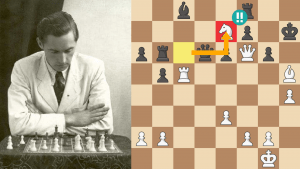
How To Understand Chess Openings
The Chess.com member alaskan asked:
“I would like to focus more on understanding rather than on lines, but almost all the opening books I can find focus on lines rather than on general ideas, so where to get this understanding from? The one book I know is Fundamental Chess Openings by Van der Sterren but that only covers each opening to a limited extent.”
JS: I feel for you since players want to know what in the world this or that opening is all about, but they rarely know these (apparent) mysteries. So they memorize a few lines, play some games (blitz or long time controls), and try to figure it all out for themselves.
Knowing more than lines is critically important, whether you’re a total beginner or player in the 2000 range. So, how can you step off the “memorize reams of theoretical variations go-around” and learn the basics, the usual plans and the many patterns associated with the opening(s) of your choice?
CHOICE ONE
If you have the cash, and if you want to solve this problem right away, hire a very strong player (IM or GM) to give you all the ins and out of your opening repertoire. Even better, have him look at your games and then create a repertoire for you based on your strengths and tastes.
This will take a while and cost a bundle, but you’ll have a lot of fun, learn things about chess that you’ve never imagined before, and (when all is said and done) you will walk away a stronger player with a serious understanding of your opening systems.
CHOICE TWO
Get Fundamental Chess Openings by Van der Sterren, pick up the tidbits he offers, fashion a repertoire based on the lines that intrigue you, buy books on your openings, and then play a zillion blitz games with it.
Make sure you get copies of your blitz games so you can look at the game and the opening book and see where you went wrong (or… gasp!… right).
Over time, you will have a good feel for your opening, though there will be quite a few subtleties that you won’t be privy to.
This basic study system isn’t expensive, and it will help you make serious leaps into opening understanding. However, if you want to really know your openings, you will need more than this. Nevertheless, for many players this is all they need.

CHOICE THREE
Find books that discuss many openings, with an emphasis on the openings’ ideas. Mr.alaskan and I already mentioned Fundamental Chess Openings by Van der Sterren, and there are other books like this too (The Ideas Behind the Chess Openings by Reuben Fine is one example).
However, one author you can count on is my old friend Yasser Seirawan, who has a talent to explain advanced ideas in clear, easy-to-understand prose. His Winning Chess Openings is well worth a look.
The Contents:
- Early Days
- Basic Opening Principles
- Classical King Pawn Openings
- Classical Queen Pawn Openings
- Modern King Pawn Defenses
- Modern Queen Pawn Defense
- An Opening Solution
- A Solution to the Queen Pawn Opening
- A Solution to the King Pawn Opening
Here’s the informative blurb:
The two greatest challenges for beginning chess players are not only to survive the openings phase, but also to choose appropriate attack and defence formations in the process. Winning Chess Openings shows players how to do both. In Yasser Seirawan's entertaining, easy-to-follow style, they are shown formations that can be used with other White or Black pieces.
Winning Chess Openings explains how to:
- Build a safe house for a king
- Estimate losses of ten moves or fewer
- Utilize the elements: time, force, space, and pawn structure
- Plan strategy based on time-tested opening principles of play
- Employ a defence for Black against any White opening
- Apply an opening for White used by World Champions
Winning Chess Openings will help readers develop a solid understanding of opening principles that can be applied to every game they play — without having to memorize a dizzying array of tedious and lengthy opening lines.
For more information look at the introduction (on Amazon), which will help you decide if this book is for you.

CHOICE FOUR
Find books that specialize in the plans, patterns, tactics, strategy, and just about everything else (history included) relating to ONE specific opening. By the way, books like this don’t need to be new. Remember: we aren’t looking for the latest computer-spawned move; we are looking for ideas and plans and patterns.
Of course, some are better than others, so please make sure that the author is making a real effort to inform you about whatever opening you intend to play. Here are some examples.
First Steps: the Colle and London Systems
by Cyrus Lakdawala (2016)
My First Chess Opening Repertoire for White
by Vincent Moret (2016)
The subtitle: "A Ready-to-go Package for Ambitious Beginners."
This book is filled with exciting, tactical lines. While these won’t fool strong players, they will often wipe the beginner opponent off the board. What I like about this book is his copious prose, which gives the reader the history of the moves and the ideas and tactics.
Let’s take a look at a couple examples:
Here Moret gives us a lot more prose (in this case with White playing d2-d3), but after that he tosses down some particulars.
Moret wrote:
As a first step, rather than precise variations to memorize, it will be very important to understand the three themes that often come up in this Italian with d2-d3:
- Early kingside castling (even sometimes downright premature).
- The pin of the Nf6 (or Nf3) after, respectively, Bg5 or …Bg4.
- The move h2-h3 (or …h7-h6, respectively), before or after castling, to counter the aforementioned pin.
These three themes are closely linked, as we will see in the illustrative games from this chapter.
His first full game went like this (the notes — and there are a lot of them — are, of course, by Moret, though I will only give his notes to moves 5 and 13 and after Black’s 14th move):
Since this book is a full repertoire for White, he gives the same history and copious notes and explanations to the Sicilian, the French, the Price and Modern Defense, and everything else.
Easy Guide to the Queen’s Gambit Accepted
by Graeme Buckley (1998)
Note the date. However, Buckley’s notes are timeless and would be just as pertinent if I lied and said the date was 2017.
In the introduction, Buckley writes a couple of long paragraphs, but I will leave those behind and start here:
With his second move, 2...dxc4, Black concedes an extra central pawn to White. This is small but significant. White will often look to take control of the center and to manufacture a spatial advantage. Black will commonly rely on queenside expansion as a means of creating counterplay. The upshot of this is that the positions are rarely symmetrical and that a fight will take place.
Throughout this book I will present, along with the opening theory, examples which illustrate the good and the bad points of the QGA. The examples from middlegame and endgame play will give a more complete picture of the QGA than just showing opening moves. They will show recurring and common themes and how to deal with them. The situations where Black gets a hard time of it are not meant to serve as a deterrent from playing the QGA; they are merely examples of how White should play if Black gets it wrong and how not to play with Black. We shall now look at some typical positions and break the rest of this first chapter into five sections:
- Queenside Expansion
- Isolated Queen Pawn Positions
- Pressure on the c-file
- White’s e5-pawn
- Central Tension and the Active Piece Play
The chapter is broken into sections like this for simplicity although quite clearly the ideas in each section overlap into one another.
Queenside Expansion
The advance of the black queenside pawns to create counterplay is one of the key ideas in the QGA. Timing is essential and the following two examples provide some insight as to how to play these positions, what to look for and what to aim for. The section is divided into two: Blocked Center and Flexible Center.
Buckley then gives sample games which illustrate the five sections mentioned earlier. And, once all five of these are addressed, the theory begins which, of course, is also saturated with explanations, strategy, etc.
By now I think you can see how useful these books can be, and there are a lot of them on just about every opening. In fact, various publishers have created a series of books for those that want prose and understanding.
One (by Everyman) is called, “Starting Out” (Craig Pritchett wrote, Starting Out: Sicilian Scheveningen [2006], and Glenn Flear wrote, Starting Out: Slav and Semi-Slav).
Another series is “Easy Guide,” which is from Cadogan (we already look into one of them: Easy Guide to the Queen’s Gambit Accepted).
And other series are “Chess Explained” and “How to Play the…”
Knowing the ideas of the openings is critically important, and books like the ones I pointed out can change your whole view of what chess is and how it should be studied.
Whether they are a bit old or new, these kinds of books (and there are an enormous amount of them) should be in just about everyone’s chess library.






